
About UsThe Numismatic Bibliomania Society is a non-profit organization promoting numismatic literature. For more information please see our web site at coinbooks.org SubscriptionsThose wishing to become new E-Sylum subscribers (or wishing to Unsubscribe) can go to the following web page link MembershipThere is a membership application available on the web site Membership Application To join, print the application and return it with your check to the address printed on the application. Membership is only $15 to addresses in the U.S., $20 for First Class mail, and $25 elsewhere. For those without web access, write to: David M. Sundman, Treasurer AsylumFor Asylum mailing address changes and other membership questions, contact David at this email address: dsundman@LittletonCoin.com SubmissionsTo submit items for publication in The E-Sylum, just Reply to this message, or write to the Editor at this address: whomren@gmail.com
BUY THE BOOK BEFORE THE COIN |
- WAYNE'S WORDS: THE E-SYLUM JANUARY 19, 2014
- KOLBE & FANNING 2014 NEW YORK BOOK AUCTION REPORT
- KREINDLER SALE AUCTION ACTION
- SWANN AMERICANA SALE APRIL 8, 2014
- U.S. MINT PUBLISHES FISCAL YEAR 2013 ANNUAL REPORT
- NEW BOOK: MEDALS OF FERDINAND THE GOOD
- HARDBOUND LAW ENGLISH GOLD COIN SALE AVAILABLE
- TOM MALLON-MCCORGRAY 1956-2014
- MORE NOTES ON JOHN BURNS
- R.W. JULIAN ON THE PRESIDENCY RELINQUISHED MEDAL
- NOTES FROM E-SYLUM READERS: JANUARY 19, 2014
- MORE ON NUMISMATIC POSTCARDS AND ALBUMS
- LUMAN BURR CIVIL WAR SUTLER APPOINTMENT DOCUMENT
- OPINIONS AND BRIEFS OF THE SOLICITOR OF THE TREASURY
- SEITZ COIN CASE INSTRUCTIONS
- WHITMAN FOLDER PRINTING PLATES
- INTERVIEW: JOHN MERCANTI'S WEDGE-TAILED EAGLE
- RANDALL ROSENTHAL'S AMAZING MONEY BOX SCULPTURE
- THE 1960S TAX-RESISTANCE "THOREAU MONEY" NOTES
- "NON-COLLECTIBLE" CIVIL WAR TOKEN DESIGNATION SOUGHT
- BANK OF ENGLAND SETS DEADLINE FOR OLD £50 BANKNOTES
- MUTILATED US NOTES RAISE MONEY LAUNDERING SUSPICIONS
- YOUSUF KARSH AND THE "DEVIL'S HEAD" PHOTO OF ELIZABETH II
- SELECTIONS FROM THE STACKS BOWERS 2014 AMERICANA SALE
- SERVICE AGENT CHARGED WITH PASSING COUNTERFEITS
- BASIC INTERGLUTEAL NUMISMATICS
- FEATURED WEB SITE: WORLD OF COINS
Click here to access the complete archive
To comment or submit articles, reply to whomren@gmail.com
WAYNE'S WORDS: THE E-SYLUM JANUARY 19, 2014

New subscribers this week include Jim Majoros, courtesy of David Gladfelter, Don Jess, John Lorenzo, and Josh Kelley. Welcome aboard! We have 1,689 email subscribers.
We've got another big issue this week. The E-Sylum inbox was overflowing with submissions and story ideas, and I paddled upstream all week trying to stay on top of the flow. My apologies to those I whose emails I missed or was unable to respond to.
This week we open with two reports on last week's Kolbe & Fanning auctions in New York City, a copy of the 1792 Mint Act coming up for sale, and three new books (including the 2013 U.S. Mint Report).
Other topics include researcher Tom Mallon-McCorgray, author Melvin S. Gilmore, literature dealer John Burns, Sutler Luman Burr, Whitman folder printing plates, and Thoreau Money.
To learn more about the Seitz Coin Case, Burn's twist, dingbats, Randall Rosenthal's amazing money box sculpture, and Intergluteal Numismatics, read on. Have a great week, everyone!
Wayne Homren
Editor, The E-Sylum
KOLBE & FANNING 2014 NEW YORK BOOK AUCTION REPORT
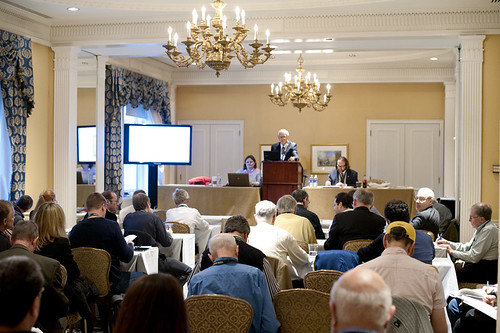
Kolbe & Fanning Numismatic Booksellers held their annual New York Book Auction on Saturday, January 11 in conjunction with the 2014 New York International Numismatic Convention (NYINC) at the Waldorf-Astoria Hotel in New York City. The two-session sale offered highlights from the libraries of Quentin Archer and Herbert Kreindler and was highly successful, with both sessions boasting sell rates of well over 90% and hitting between 130% and 150% of total estimates, with well over $900,000 in total sales including the buyer premium.
The first session saw the firm offer selections from the remarkable library on Russian numismatics formed by Quentin Archer. The Archer library is especially strong in pre-Petrine material and in references on the coins and medals of Peter the Great, with some coverage of later periods. The Archer sale saw very aggressive competition, with some notable lots including:
Lot 30, Grand Duke Georgii Mikhailovich’s very rare work on the coins of Peter I, brought $17,000 hammer on a $10,000 estimate (all prices herein are hammer prices).
Lot 32, a set of the French edition of the Grand Duke’s corpus, also brought $17,000 hammer on a $10,0000 estimate.
Lot 59, a rare complete set of the Zapiski Numizmaticheskago Otdelniia (Imperatorskoe Russkoe Arkheologicheskoe Obshchestvo, 1906-13), sold for $5500 on a $3000 estimate.
Lot 95, a compete run of the Trudy Moskovskago Numizmaticheskago Obshchestva (Moskovskoe Numizmaticheskoe Obshchestvo, 1898-1905), brought $5750 on a $2750 estimate.
Lot 96, a fine complete set of the Numizmaticheskii Sbornik (Moskovskoe Numizmaticheskoe Obshchestvo, 1911-1915) from the Ran Zander library, sold for $6500 on a $4500 estimate.
Lot 104, a beautiful copy of Oreshnikov’s masterwork, with both supplements, sold for $3750 on a $1250 estimate.
Lot 120, a nearly complete set of the very rare catalogue of Yakov Yakovlevich Reichel’s extraordinary collection, sold for $6000 on a $3500 estimate.
And that was just the beginning of an exceptional day. Starting at noon, Kolbe & Fanning offered highlights from the outstanding and comprehensive library on ancient numismatics formed by New York coin dealer Herbert Kreindler. This part of the sale was conducted in association with Fritz Rudolf Künker GmbH, of Osnabrück, Germany. The Kreindler library is well-known for its extensive nature, and brought participants from all over the world. Some sale highlights included:
Lot 1029, a complete set of the Numismatic Chronicle (1838-2012) sold for $32,500 hammer on a $20,000 estimate.
Lot 1030, the complete set of the extremely rare Zeitschrift für Numismatik, previously in the library of the firm of Münzen und Medaillen, sold for $45,000 on a $40,000 estimate.
Lot 1037, a complete set of Spink & Son’s Numismatic Circular, sold for $12,000 on a $6000 estimate.
Lot 1064, the very rare photographic record of the collection of Carlos de Beistegui, sold for $7500 on a $3500 estimate.
Lot 1127, an exceptional first edition set of A Catalogue of the Greek Coins in the British Museum sold for $14,000 on a $7500 estimate.
Lot 1254, a lovely set of Rizzo’s important Monete greche della Sicilia, sold for $8500 on a $3500 estimate.
Lot 1297, Svoronos and Pick’s rare and important Les monnaies d’Athènes, sold for $7000 on a $2500 estimate.
Lot 1541, an extraordinary group of Jacob Hirsch’s bidbooks of his first twelve catalogues, sold for $23,000 on a $12,500 estimate.
Full prices realized lists and PDFs of the catalogues are available on the Kolbe & Fanning website at www.numislit.com. Printed catalogues are still available from the firm at $20 for the set. We wish to thank all of our clients for their participation in these exciting sales.
Kolbe & Fanning Numismatic Booksellers LLC
141 W. Johnstown Rd.
Gahanna, OH 43230
(614) 414-0855
Cell (614) 256-8915
Fax (614) 414-0860
df@numislit.com
www.numislit.com
Members ANA, ANS, IAPN
KREINDLER SALE AUCTION ACTION
 The 2014 New York Inc (NYInc) show featured sales starting on one Sunday and ending on the next Sunday. Several major auction companies participate in sales that are held daily in conjunction with the show. The Saturday, January 11, 2014 sale of the Herbert Kreindler Library contained six hundred well described lots, with some of them illustrated.
The 2014 New York Inc (NYInc) show featured sales starting on one Sunday and ending on the next Sunday. Several major auction companies participate in sales that are held daily in conjunction with the show. The Saturday, January 11, 2014 sale of the Herbert Kreindler Library contained six hundred well described lots, with some of them illustrated.
The photo accompanying this story shows David Fanning on the left and George Kolbe on the right. George is holding up the Kreindler catalog which was Public Auction and Mail Bid sale No. 132. The auctioneer for this sale was Harmer Johnson. There was a separate catalog for the Mail Bid portion of the Kreindler library. That sale was held by Kolbe & Fanning, along with, and in conjunction with Fritz Rudolf Kunker at a later date.
This Saturday sale though was one we would have loved to participate in. Because we were working at the show we could only look into the sale once in a while. The room was packed with just about every chair taken. The sale had some material we would have loved to get for our library but the prices were out of sight. We spoke with some friends who were active bidders at the sale. They said the estimates were surpassed on many of the lots. Some of our friends were even shut out, even though they had high bids for the material they wanted. After the sale we saw huge smiles on Mr. Kolbe, Fanning and Kreindler. We cannot wait to get the PRL for this sale. The Herbert Kreindler sale catalog will be a huge collectible and we are glad that we have a copy.
SWANN AMERICANA SALE APRIL 8, 2014
“Our April 8 Americana auction is still taking shape as of press time, but highlights will include a nice 1601 set of Herrera’s Historia General de las Hechos de los Castellanos: a first printing of the 1792 Act Establishing A Mint, and Regulating the Coins of the United States, signed by Thomas Jefferson: a rare 1860 report on the Young Men’s Republican Union’s extensive efforts to secure Lincoln’s election: a collection of California gold rush graphics and much more. “
For more information, see: Apr 8 1:30 PM Printed & Manuscript Americana (www.swanngalleries.com/departments/Printed-and-Manuscript-Americana/)

U.S. MINT PUBLISHES FISCAL YEAR 2013 ANNUAL REPORT
 Bibliophiles are familiar with the annual report of the Director of the Mint, which often contain a trove of great numismatic information. The Government Printing Office handled printing and distribution. Some were paperbound, and many others hardbound in the familiar black cloth.
Bibliophiles are familiar with the annual report of the Director of the Mint, which often contain a trove of great numismatic information. The Government Printing Office handled printing and distribution. Some were paperbound, and many others hardbound in the familiar black cloth.
The United States Mint’s Fiscal Year 2013 annual report has just been published online, where it is available as a .pdf file. Here are a few selected images - be sure to read the full version online. -Editor
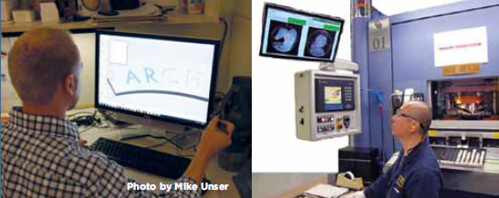
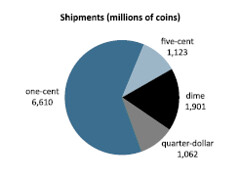
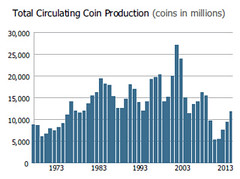

To read the complete report, see: United States Mint’s Fiscal Year 2013 Annual Report (www.treasury.gov/about/organizational-structure/ig/Audit Reports and Testimonies/OIG14015.pdf)
NEW BOOK: MEDALS OF FERDINAND THE GOOD
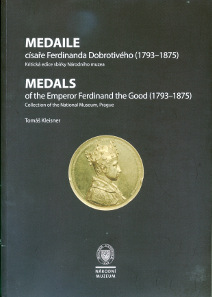 Tomas Kleisner, Medals of the Emperor Ferdinand the Good (1793-1875).
Collection of the National Museum, Prague.
National Museum, Prague, 2013. 192 p., 21x29.8 cm, all illustrations coloured. Paperback. ISBN: 978-80-7036-396-6. Price: 300 CZK (= ca. 12 Euro) + Postage and Packing.
Tomas Kleisner, Medals of the Emperor Ferdinand the Good (1793-1875).
Collection of the National Museum, Prague.
National Museum, Prague, 2013. 192 p., 21x29.8 cm, all illustrations coloured. Paperback. ISBN: 978-80-7036-396-6. Price: 300 CZK (= ca. 12 Euro) + Postage and Packing.
Tomas Kleisner’s richly illustrated and well written introduction to his corpus of the medals of Ferdinand the Good contains all this and more details about the life of the Emperor. The introduction is followed by a highly informative text about the role of medals in the 19th century. The author explains for instance who was involved in the decision-making process of issuing official medals in honour of the emperor, or how the mints organised the sales of those medals to private customers. In addition, there is a chapter on the emperor’s coinage as well as on the National Museum’s other collections.
The heart of the book – the catalogue of the medals – begins on p. 52. This catalogue is exemplary and I wish more authors would pay as much attention to detail as Thomas Kleisner does in describing and commenting the figures and in researching potential sources or influences in other media. The high-quality pictures and numerous additional illustrations are a visual delight. Every piece is illustrated in one metal. Occasion, place and year of minting as well as the die cutter are included in the title. Inventory number and numismatic details of the pieces in the Prague collection are followed by an exact description of the pictures, including the mostly Latin captions and their English translations. A commentary adds a number of interesting facts about the event itself, the die cutter or the particular issue in question. Each entry is completed by extensive bibliographic references.
This exemplary catalogue contains 61 medals and is a truly valuable addition to each library. All other 17 medals of Ferdinand of which pieces are known in coin cabinets or auction catalogues are mentioned in the introduction giving pictures and a description. They are also to be found in the index, which makes this book a real corpus. Tomas Kleisner’s contribution is twofold because not only has he written a wonderful book, but he has also translated the text into English in order to make it accessible for an international community.
Please contact the author via email ( tomas@kleisner.cz ) if you are interested in purchasing a copy of the book. There are only 200 copies available and I recommend that you get hold of one as soon as possible.
To read the complete article, see: The medals of Ferdinand the Good (1793-1875) (www.coinsweekly.com/en/News/4?&id=2522)
HARDBOUND LAW ENGLISH GOLD COIN SALE AVAILABLE
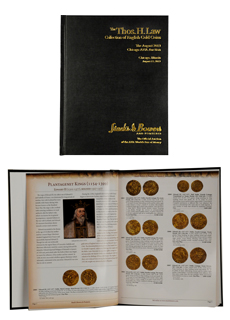 Perhaps Thos. Law was inspired by his father’s
expertise in Shakespeare, but whatever
the reason, he chose to collect the gold
coins of England. Over the years, Thos.
Law assembled one of the most extensive
collections of English gold coins and, seeing
the educational value of his collection,
exhibited the collection throughout the
country at various numismatic conventions.
Perhaps Thos. Law was inspired by his father’s
expertise in Shakespeare, but whatever
the reason, he chose to collect the gold
coins of England. Over the years, Thos.
Law assembled one of the most extensive
collections of English gold coins and, seeing
the educational value of his collection,
exhibited the collection throughout the
country at various numismatic conventions.
Assembling the collection over the course of several decades, Mr. Law became close with Harvey and Larry Stack, who not only sold coins from their extensive inventory, but would bid on his behalf on coins that came up for auction in London and elsewhere. While Mr. Law was assembling his collection of gold coins, Larry was assembling his collection of English silver coins, and the two numismatists conversed on the mutual histories and other aspects of their specialties.
To read the complete catalog online, see: The Thos. H. Law Collection of English Gold Coins (media.stacksbowers.com/VirtualCatalogs/2013/Stacks-Bowers-Ponterio/2013_09SBP_AugANA2013_Law_Catalog_LR.pdf)
THE BOOK BAZARRE
TOM MALLON-MCCORGRAY 1956-2014
Eric Schena writes:
I received news earlier this week that Tom Mallon-McCorgray passed away on 9 January. I did not know him personally, but his research on ancient and medieval Asian numismatics was highly influential on my studies. He authored a website that contained invaluable information on some of the fantastic coins from Central Asia, especially those of the various Hephthalite tribes, the coins of Sogdiana and Bactria, and a superb collection of Sassanian coins (his sections on reading Sassanian coins is especially helpful). His site certainly fostered a keen interest in these lesser known but no less important areas of numismatics, for which I am most grateful.
To visit Tom's web site, see: The Coins and History of Asia (www.grifterrec.com/coins/coins.html)
For more information on Tom, see: Tom Mallon at Coming Home Hospice, SF (www.youcaring.com/medical-fundraiser/tom-mallon-at-coming-home-hospice-sf/44462/update/110948)
MORE NOTES ON JOHN BURNS
Howard A. Daniel III writes:
John and I have had many long talks about numismatics and life at shows! I last saw him at a Baltimore show. I will miss him!
Bob Metzger of Lakeville, MN writes:
I'm glad I got to spend time with John last May at EAC in Columbus. Chris (my wife) had also met him twice: in NYC a few years back, at the January NY International show, and once in Milwaukee at another International type show. She liked him, and (of course) he liked her.
Sam Deep writes:
I will sorely miss my weekly conversations with John. Our lively banter covered the political, coin show, friends, food, guns, and faith waterfronts. Our agreement on these topics is what drove us to dial up each other so often.
John was as good a person as I know. And my family felt that, too. At ANA and PAN conventions my son David and grandsons Josh and Nick would spend as much time at his table as I did. He never hung up without sending his best to Dianne.
Men with the honor, principal, and integrity of John Burns do not enter our lives often enough. He has left a big hole.
Bruce Perdue writes:
I am saddened to hear about John Burns. I helped John unload and load his books numerous times at the Central States Anniversary Convention. John was a gentleman and a scholar. I will miss him!
Robert Zavos writes:
I spent a few hours with John at FUN on Thursday and Friday as I do almost every year. He was larger than life as usual and in good spirits with many great stories. He reminded me of our great trips to Cincinnati and St Louis and to special group visits with Armand Champa and Eric Newman. He was an amazing character in our numismatic world. I am truly saddened and shocked.
Pennsylvania Association of Numismatists President Tom Uram writes:
Pat McBride and I helped John close up on Friday evening at the FUN show. He told me when putting the tarp on the boxes that I needed to learn the "Burn's twist" on how to secure the ends to the boxes! He also let us use his table at this show for PAN info including our banner. He certainly was a real ready wit and a great person to debrief with at a show.
David Gladfelter writes:
The Big Guy got his physical workout by lugging his book inventory back and forth to the shows, and he brought substantial tonnage of them. You could almost always find items you wanted, and new issues were on hand in multiple copies. If a book seemed interesting but you weren’t familiar with the topic or the author, John would give you a verbal review of the book warts and all, which opened many a new horizon. On a good day he would only have to take 95% back to his home.
It was not financially remunerative work, but even so, you could see that he enjoyed it although he would always be grumbling about something. Both his buying and selling prices were fair. He was a regular at the annual Garden State Numismatic Association show in Somerset where he would set up in the lobby where everyone would go past, browse and visit.
He was usually placid and good natured, but when he waxed enthusiastic he would use picturesque expressions such as “I would kiss (him/her) on all four cheeks to … “ (you finish the sentence). If you hear me use that or similar expressions you will know where it came from. John will be remembered in song and story.
Ginger Rapsus writes:
I was sorry to hear about John Burns. I had spoken with him many times at shows, and made a point of visiting his table. Or should I say, tables and shelves! He always had lots of good stuff to look through.
Byron Weston writes [in the Colonial Numismatics Yahoo Forum]:
I was shocked to have read about John's passing in last night's E-Sylum. I got to know John quite well at PAN shows and saw and talked with him at several others. He had a wealth of knowledge, perhaps even more than most people realized; he was THE numismatic trivia master, hands down. What most people don't know is that John didn't just deal in and read numismatic books, he was also a collector - of porcelain notgeld - now there's a trivia question for the ages - in John's honor, of course...
David T. Alexander writes:
I was shocked at the sudden death of John Burns. He was a truly remarkable man and numismatist, with whom I once had a somewhat unusual interaction. In 1991 the American Numismatic Association launched a brilliant new attraction for its major convention, the World Series of Numismatics. Designed by James Taylor, this was an elaborate and challenging numismatic version of the TV show Jeopardy, complete with a $30,000 electronic game board and competing teams of notable numismatists.
The first game featured a cast of numismatic leaders and glitterati who generally did poorly. Celebrity was not the same as depth of knowledge, fast thinking and faster footwork! Anthony Swiatek and I formed a team called "Minerva's Conquerors" and won, if I recall correctly, five times. John Burns and John Kraljevich nearly beat us when John K was only 14! They did beat us when John K was 17. The late bibliophile Ken Lowe recorded in his "Money Tree" column that he was seated next to John K's mother Gail Baker for their winning game, "Gail is punching my left arm... they're gaining, Gail is punching my arm... They did it, they won, but my pitching career is definitely over!!!"
"Big John" Burns was a contrast to his more mercurial team mate, but made a solid, ongoing contribution to their victory. Players had to have three basic things: LUCK (questions on the board that they could answer); SPEED (push the button to block out opponents, FAST); then and only then KNOWLEDGE to answer the questions correctly! Perhaps helped by their contrasting personalities, the two Johns had all three. "Big John" will be missed.
Fred Lake writes:
John Henry Burns was a giant of a man, both in size and intellect. His unwavering friendship and dedication to the craft of a bibliopole were attributes that I noted often in our weekly telephone chats. John was a firm believer in doing things the American way and had little welcome for those that were not on that path. He worked hard schlepping books around the country to the different venues and he dispensed information like a modern-day Johnny Appleseed. He will be missed.
John and Nancy Wilson write:
We took this photo at the Chicago ANA World's Fair of Money in 2013. Richard Mantia and family were helping John at his table. They were close friends of John Burns and helped him the entire show.

When we were informed at the NYInc by Kerry Wetterstrom that John Burns had passed away at the FUN show we were deeply saddened. We have known John for a long time and it would be hard to find a better person anywhere in our hobby. Over the years I even helped him with his displays, either setting them up or breaking them down. He worked very hard lugging many boxes of numismatic books from convention to convention. We always made sure to stop and talk to him during the shows that our paths crossed. At times we even purchased a book from him. His knowledge of numismatics covering just about any area was bordering genius. He knew the books he was selling and what was between the pages of many of them.
Some years back John participated in the ANA World Series of Numismatics. At one of them we think his team might have won the championship. John Burns had a heart the size of his body. As a literature dealer his service to the numismatic hobby was extremely important. He set up at dozens of conventions every year - large and small. He was friendly to everyone who stopped by his table. If he didn't have the reference a customer was looking for he would try to find it for them. We don't think anyone can replace John Burns and the service he did for the hobby.
Like most of the readers of The E-Sylum we always worried about his weight. It was a constant battle for John to try to take a few pounds off. We thought the world of John and now he is no longer with us. We are sure that this honest, friendly and generous person and numismatist is helping the Lord with the library in heaven. Our sincere condolences to the John Burns family. Rest in Peace John - you will always be in the thoughts and prayers of your thousands of friends here on earth.
Brad Karoleff writes:
On Friday January 10, 2014 numismatics lost one of its’ greatest supporters and many of us lost a great friend. John Burns passed away in his sleep after enjoying his final night on this earth in the company of five of his friends participating in one of his favorite pastimes- dinner at a good restaurant!
John chose the place for our annual Friday night FUN dinner this year, a Brazilian steak house on International Drive. The party consisted of a cadre of John Reich Collector's Society (JRCS) members Charlie Horning, Richard Meaney, Steve Crain, Glenn Peterson, and I. The evening was full of the usual dinner banter, jokes and other lies. The waiters were constantly tempting us with delicious cuts of meat. Wine flowed and desert followed. We all left satisfied and ignorant of the event that would change the way we view Orlando forever……
Saturday morning dawned as the other days at FUN had with breakfast at Denny’s. Charlie and I had roomed together and we were joined by the rest of our dinner companions sans John for a farewell breakfast. After opening my table at the convention I noticed that John had not made the opening bell that morning. I thought that the food and alcohol had taken its toll and that he decided to sleep a little late.
After a while I began calling him attempting to find out why he was not there. I left the convention early that day to play a round of golf with Charlie and the calls to John continued. I finally got ahold of Paul Cunningham as I knew he was close to John and was staying at the same place as John. He gave me the terrible news just before dinner time on Saturday.
I realize that you all know that sinking sick-to-your-stomach feeling that you get when you receive bad news, but this was one of the worst pangs I have felt. Charlie and I soon retired to the hotel restaurant for our personal wake in John’s honor.
Everyone who knew John realized his depth of character. His friendship was without reserve. His numismatic knowledge was second to none. He could converse with you on many topics seamlessly. Education was John’s greatest pleasure. Books came easily to John; he never met one he did not want to read. He was a genius that had a difficult time transferring knowledge into a livelihood. All of us who knew him received much more from him than he did from any of us.
John is gone now, but his memory will be with us forever. There will not be a coin show where he will not be remembered by someone. I will have a hard time reaching for a book from my library without a remembrance of him. He was a giant in our hobby in more ways than one.
We all have favorite stories we tell about our friends once they are gone. I’m sure there will be more about John than the average person. I remember a couple of years ago at FUN when John, Steve Roach and I went to dinner. John drove and that was the subject of much amusement. John had a large white van, (which he named Shamu), that had metal grates on the windows in the back. There were no back seats so he could load more boxes of books for his trips.
I sat in the passenger side seat and Steve climbed into the back for the short trip. I can’t remember who started it but we thought that if a policeman saw us riding with Steve in the back of this van we may be stopped for kidnapping. Steve and John traded one liners back and forth and I was reduced to a fit of laughter. I could hardly breathe I was laughing so hard. It will be a night I will cherish forever.
Another time John came to Cincinnati for a coin show. We had decided to go to the local shooting range after setup. John brought his 45 with him and I brought a few items from home. We had a great time shooting with a few other dealers before going to dinner. John would often refer to me as “Annie Oakley” after this experience. I only remember the joy in seeing John flinch when he used my 357 snubby with HOT loads! He laughed about it and even brought it up during this last trip.
There are a couple of old sayings about death I would like to share. One is the hope that the deceased is in Heaven before the Devil knows you are dead. In this case I think it was a good thing that the Devil was busy elsewhere when John sauntered by on his way to the Pearly Gates. The other is that a life has not been wasted if only one tear is shed at its passing. If this is the case I know John’s life was very meaningful as we all have shed our share of tears in his memory already.
Rest in Peace, my big buddy. We will not see the likes of you again in our lifetimes.

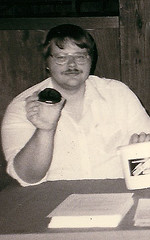 We'll close with this shot of a beardless John Burns circa 1987, provided by Pat McBride.
We'll close with this shot of a beardless John Burns circa 1987, provided by Pat McBride.
Over 100 people responded to John Kraljevich's call for participants in the Coin World memorial ad for John. JK writes: "I inserted two in-jokes into the signatures that I think John would get a kick out of." QUICK QUIZ: when the ad comes out, who can identify the fake names? Bonus Points: why are the names significant to John? -Editor
To read the earlier E-Sylum article, see:
JOHN H. BURNS 1958-2014
(www.coinbooks.org/esylum_v17n02a02.html)
EMPLOYMENT OPPORTUNITY!
Live and Work in Southern CaliforniaStack’s Bowers Galleries offers an important employment opportunity for the right person. We are seeking an experienced numismatist in the American series—coins, tokens, medals, and paper money—to work with our “dream team” of catalogers, building on the tradition of the Ford, Eliasberg, Bass, Cardinal, Norweb, Battle Born and other great collections.
If you can write in an authoritative and compelling manner with a high degree of accuracy, this may be just right for you! You will be working in Irvine, a modern community in dynamic Orange County, California—one of the finest areas to live. We offer generous benefits including medical and dental coverage, 401K plan, and more. Our offices are in our own modern, state-of-the art building with all amenities.
If you would like to be considered for this position please contact Q. David Bowers by mail or by email with your resumé, samples of your past writing (on numismatics or other subjects), and salary requirements: Mail to the attention of Q. David Bowers, PO Box 1804, Wolfeboro, NH 03894. Email to: Ckarstedt@stacksbowers.com
R.W. JULIAN ON THE PRESIDENCY RELINQUISHED MEDAL
Apparently there is still some confusion regarding the so-called restrikes of the Presidency Relinquished medal. The following points apply:
1) Mr. Lopez credits me with various remarks concerning the original dies by John Reich and the published medals by Joseph Sansom. The material in question was actually written by Stewart Witham, who was especially interested in this medal. Witham is in fact credited in the text for his material.
2) The quote from Franklin Peale was not in the original TAMS medal book because it was not found until after publication.
3) There is no question whatsoever that the 1859 dies were in fact hubbed from the original Reich dies. It would have been virtually impossible for an engraver to cut a pair of dies that exactly matched the originals. The only artist at the Mint in 1859 capable of such work was A.C. Paquet, who was quite busy on other matters. In addition, even had a skilled engraver been able to exactly duplicate the motifs it would have taken a considerable amount of time; the hubbing described below could have been accomplished in a matter of days. The fact that Baker also says that they were hubbed is merely added proof; to be precise Baker says that the dies were made from “hubs taken from the original dies,” which is not the same as hubbing an entire die.
4) Mr. Lopez indicates that he requires further written proof of the work before he will accept that the 1859 dies were hubbed. Records of hubbing were not kept at the Mint but the Peale quote, the posted illustrations, and the Baker citation are in themselves sufficient proof.
5) As the method of hubbing medal dies is not well known it is perhaps best to describe the process. A piece of soft steel, just large enough to cover the main motif (such as the head of Washington) was pressed against the original negative dies in the large screw press. It took several blows to bring up the design, with annealing between the blows.
6) The result of the work was a positive hub in soft steel of Washington’s head. The engraver then made changes or improvements (such as removing imperfections) in the soft steel hub. The hub was then hardened and used to punch the vignette into a new die. The lettering was added by one of the engraving staff and the die hardened for use. Similar steps held for the reverse.
To read the earlier E-Sylum article, see: PRESIDENCY RELINQUISHED MEDAL RESTRIKE REVISITED (www.coinbooks.org/esylum_v17n02a12.html)
NOTES FROM E-SYLUM READERS: JANUARY 19, 2014
Author Melvin S. Gilmore Information Sought Robert Rightmire writes:
Part of the mystery regarding author Starr Gilmore has been solved by Bob Olson of Springfield, IL. He reports that Starr’s given first name was Melvin (S. Gilmore), born Aug. 6, 1903 and died in Spokane, Washington in June 1977. To date no one has been able to locate any articles other than those cited by Darryl Atchison in his posting for E-Sylum. Might someone in the Spokane area remember Gilmore? The search continues. Thanks for your help.
To read the earlier E-Sylum articles, see:
QUERY: INFORMATION ON AUTHOR STARR GILMORE SOUGHT
(www.coinbooks.org/esylum_v16n01a22.html)
CORRECTION: STARR GILMORE BIBLIOGRAPHY
(www.coinbooks.org/esylum_v16n02a13.html)
ABOUT THE AUTHOR: STARR GILMORE
(www.coinbooks.org/esylum_v17n02a22.html)
More on Heath's Medal Catalogs Jan Monroe writes:
I subscribed to Robert Heath's books on New England states commemorative medals of cities and towns. He did not want to waste paper so he would sell updates to his books that just replaced pages that were outdated and added new pages for new finds. It was a complicated task to get his updated pages and go thru each state inserting the new and tossing out the old pages.
For example, the book on Connecticut is listed as Volume 1, seventh edition with the last updates I received. The books were not bound and were issued as loose pages punched for a three ring binder. (I found that old Franklin Day Planner binders worked great for this purpose.) I would be surprised if there are very many complete sets of these issues due to the work required to keep them all up to date.
I have books for Connecticut Vol. 1, 7th Ed.; Maine Vol. 1, 6th Ed.; New Hampshire Vol. 1, 7th Ed.; Vermont 5th Ed.; Massachusetts Vol. 1, 10th; Vol 2, 10th Ed.; Vol 3 10th Ed.; Vol 4 10th Ed.; and Rhode Island 5th Ed.
To read the earlier E-Sylum article, see: ROBERT HEATH'S NEW ENGLAND MEDAL CATALOGS (www.coinbooks.org/esylum_v17n01a20.html)
Howard Berlin on Hyperinflation Banknotes Howard Berlin writes:
In the last E-Sylum, you mentioned Zimbabwe notes. Attached is an article I wrote in 2011 about the Zimbabwe notes (and a few others) .
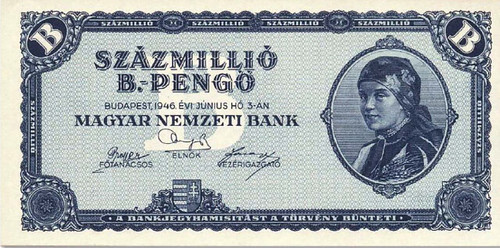
Hungary's 100 Million Billion Pengo Note of 1946
To read the earlier E-Sylum article, see: WORTHLESS ZIMBABWE NOTES RISE IN PRICE (www.coinbooks.org/esylum_v17n02a25.html)
Back Story: Good Morning America Chris Fuccione writes:
In the article Quiz Answer: City of New Orleans (from Volume 16, Number 53, December 29, 2013), it was mentioned that ABC got the name of their show Good Morning America from the song's chorus.
Talk about revisionist history! This is something that ABC would like people to believe but that is the furthest thing from the truth. ABC stole the name from a morning talk show Good Morning that was on WCVB, their Boston affiliate.
This video from 1989 has Bob Bennett who was the General Manager of WCVB from 1972-82 talks about (start video at 6:06) how he almost got into a fist fight with Fred Silverman who was at the time the head of ABC Entertainment over ABC taking the title without asking WCVB first. As a result WCVB had to change the name of their show from Good Morning to Good Day.
To watch the video, see: WCVB-TV "Good Day!" Retrospective - 1989 - Part 1 of 2 (www.youtube.com/watch?v=J6WM-ToO9Jw)
To read the earlier E-Sylum article, see: QUIZ ANSWER: CITY OF NEW ORLEANS (www.coinbooks.org/esylum_v16n53a08.html)
An Even Earlier Dealer Telephone Number Harold Welch writes:
In the January 12, 2014 issue of The Esylum, the title of earliest coin dealer telephone number was awarded to Thomas Elder for his September 1908 listing of Grammercy 5899. Perhaps this is the earliest telephone listing of an American coin dealer, but the title banner of the December 1892 issue of Spink's Numismatic Circular states, "Telephone: 1327". This was the first issue of the Numismatic Circular, so I can't say how long they may have had that number in service. I suspect that both this English record and Elder's American record would fall if anyone was interested enough to do a bit of research.
To read the earlier E-Sylum article, see: EARLIER COIN DEALER PHONE NUMBERS FOUND (www.coinbooks.org/esylum_v17n02a20.html)
Another Optical Illusion On Coins François R. Velde writes:
For another beautiful example see this Phocaean coin (same time period):
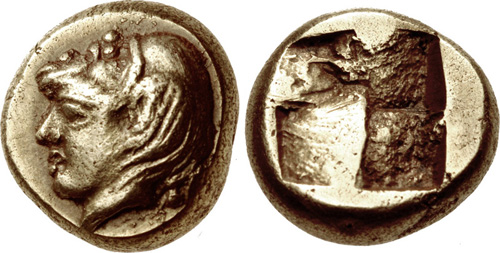
IONIA, Phokaia. Circa 478-387 BC. Hekte (Electrum, 9mm, 2.58 g). Head of a young satyr to left, wearing a mask of Silenos on top of his head; to right, small seal swimming downwards. Rev. Quadripartite incuse square. BMC 43. Bodenstedt Em. 70. Very rare. Lightly toned, some light cleaning marks and porosity. Nearly extremely fine.
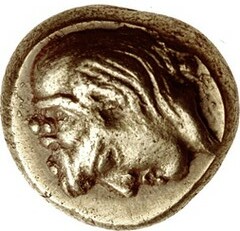 This extraordinary obverse shows a young satyr who has just performed a satyr dance disguised as Silenos, an old satyr! He is clearly not a human dancer since he has an animal ear of his own. Of course, we know that the dance has finished since he has raised his Silenos mask, which is of a bearded and bald satyr, and placed it on top of his head! For further discussion of this enigmatic type (better known from vase painting) see SNR 52, pp. 44-45.
This extraordinary obverse shows a young satyr who has just performed a satyr dance disguised as Silenos, an old satyr! He is clearly not a human dancer since he has an animal ear of his own. Of course, we know that the dance has finished since he has raised his Silenos mask, which is of a bearded and bald satyr, and placed it on top of his head! For further discussion of this enigmatic type (better known from vase painting) see SNR 52, pp. 44-45.
François adds writes:
Very interesting indeed - I had never seen it before your newsletter on the Philistine coin. The Phocaean image is described as a young satyr having lifted a mask of Silenus at the end of a dance. That may be the origin of the motif, but as it appears on the coin the mask is not delineated as such, and the design really seems to be of the optical illusion variety.
To read the full auction lot description, see: Lot 28 967678. IONIA, Phokaia. Circa 478-387 BC (www.cngcoins.com/Coin.aspx?CoinID=250523)
To read the earlier E-Sylum article, see: OPTICAL ILLUSIONS ON COINS AND MEDALS (www.coinbooks.org/esylum_v16n53a16.html)
Punctuation Fanatics Bob Van Arsdel writes:
Aren't punctuation fanatics called "dingbats"?
MORE ON NUMISMATIC POSTCARDS AND ALBUMS
I would like to make a couple of corrections to Frank Draskovic’s interesting piece last week about coin postcards.
First, the original publisher of the “H.S.M.” type of cambist cards was Hugo Semmler of Magdeburg. His name and city appeared on the earliest of his cards (see upper left corner of accompanying illustration). For some unknown reason, Semmler later replaced his name and city with the initials H. S. M. (for Hugo Semmler, Magdeburg). The reason may have been so that Semmler could license his postcards to other distributors and jobbers; the later cards indicate that they were made in Bavaria as well as in Saxony. A later version of the same post card is also illustrated, showing these initials. Draskovic is correct in dating the earliest of the Semmler cards to the year 1904. One of his cards in my collection is postmarked 25 April 1904, the earliest postmark seen thus far.
(Coin postcards, embossed as well as surface printed, were made before 1904, but were not of the cambist variety showing currency exchange rates. One such is a New Year’s greeting card made by Paul Süss of Dresden with embossed 2 and 20 mark German coins, postmarked 31 December 1900. Another has images of Switzerland’s first silver coins of 1850 and later, made by L. Meyer of Canton Luzern and postmarked 5 March 1900.)


Second, the album in which Mr. Draskovic’s collection is housed is not a “Blümel” album. It is one that was sold by Fortuna Hornung, proprietor of a stationery store in Vienna, as the detail showing her label indicates. The address on the label is an earlier location of her store, Josefstädterstrasse 58. A few years later she had moved to No. 82 on that street, and by 1914 the store was being used as the address of Alfred Josef Blümel (see illustration of his postcard album with 1914 date). By that time Semmler’s business had been succeeded by a Berlin publisher, Max Heimbrecht.
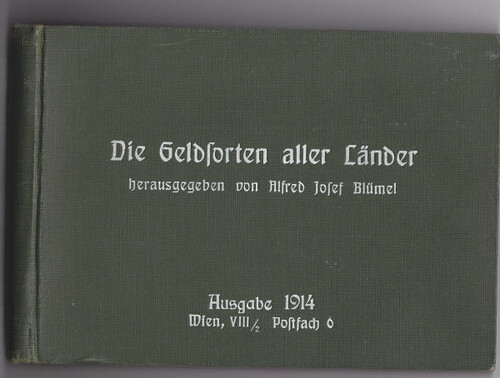
I hope these postcards could become a project for E-Sylum readers. What little I know about them was written up in our print journal, The Asylum, several years ago (Spring 2005 and 2006 #1).
Don Kolkman writes:
Interesting articles on coin card postcards!
I have one that doesn't appear to be from the same groups shown. I have attached front and back for your observation. The scan may show the left vertical strip on the flag as green, but looking at the card it appears to be blue and therefore a French flag. The flag doesn't have the Mexican symbol in the center as well. Lower right corner of the front also has "Le Mexique".
The card is used and appears to have had a stamp on the front (no longer there) as well as the back. The postal stamp is Scott # 634 issued in 1922.
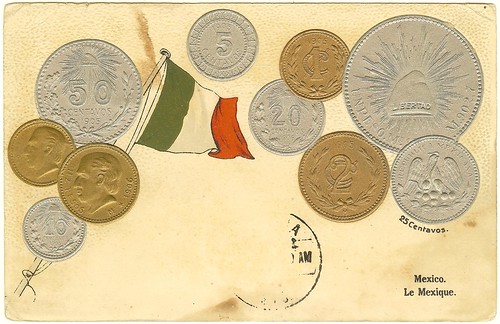
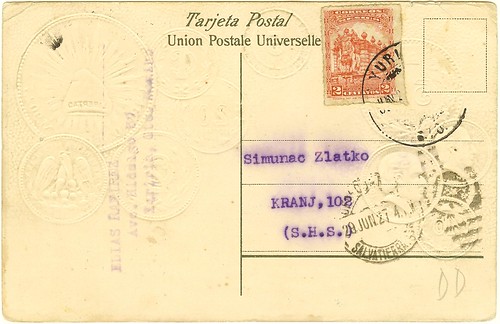
Don adds:
I just ran across a bunch of coin cards on a German ebay site. I have attached a picture from his site showing the exact same Mexican coins. My card appears to have been made from the same dies at a later date.
The site has 35 different coin cards for sale as Buy It Now with different prices. Unfortunately the US card is no longer available as I purchased it.
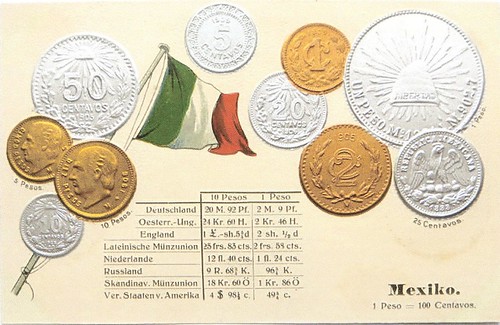
To view the eBay postcard lots, see: 35 results found for Geld / Münzkarte
To read the earlier E-Sylum article, see: BLUMEL COIN CARD POSTCARD ALBUM CENSUS (www.coinbooks.org/esylum_v17n02a29.html)
LUMAN BURR CIVIL WAR SUTLER APPOINTMENT DOCUMENT
Duane Feisel writes:
This appears to be a very significant Civil War document that would appeal to a wide audience: "1864 Civil War Camp Douglas Sutler Appointment - Signed by Brig. Genl W. W. Orme." Perhaps it would be of interest to some of the readership of The E-Sylum.
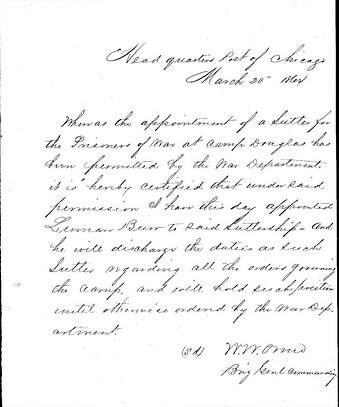 Headquarters Post of Chicago
Headquarters Post of Chicago
March 30” 1864
Whereas the appointment of a sutler for
the Prisoners of War at Camp Douglas has
been permitted by the War Department
it is hereby certified that under said
permission I have this day appointed
Luman Burr to said Sutlership – And
he will discharge the duties as such
Sutler regarding all the orders governing
the camp, and will hold such position
until otherwise ordered by the War Department.
(SD) W.W. Orme
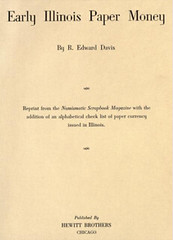 To read the text of the R. Edward Davis monograph, see:
Early Illinois paper money
(archive.org/details/earlyillinoispap00daviiala)
To read the text of the R. Edward Davis monograph, see:
Early Illinois paper money
(archive.org/details/earlyillinoispap00daviiala)
To read the complete eBay lot description, see:
1864 Civil War Camp Douglas Sutler Appointment - Signed by Brig. Genl W. W. Orme
(www.ebay.com/itm/-/380816020245)
OPINIONS AND BRIEFS OF THE SOLICITOR OF THE TREASURY
Ron Guth writes:
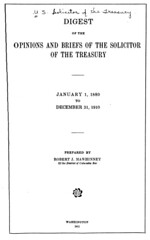 I came across an interesting reference on the web that may be a rabbit-hole down which some researcher might wish to descend (assuming someone hasn't already). It's the Digest of the Opinions and Briefs of the Solicitor of the Treasury; specifically those of 1/24/1888 and 11/27/1909. The former refers to the Linderman case and the decision to shut down Lyman Low's sale of his pattern coins. The second refers to the $50 Unions.
I came across an interesting reference on the web that may be a rabbit-hole down which some researcher might wish to descend (assuming someone hasn't already). It's the Digest of the Opinions and Briefs of the Solicitor of the Treasury; specifically those of 1/24/1888 and 11/27/1909. The former refers to the Linderman case and the decision to shut down Lyman Low's sale of his pattern coins. The second refers to the $50 Unions.
To read the Digest on Google Books, see: DIGEST OF THE OPINIONS AND BRIEFS OF THE SOLICITOR OF THE TREASURY, JANUARY 1, 1880, TO DECEMBER 31, 1910,

SEITZ COIN CASE INSTRUCTIONS
Recently Northeast bought a copper collection that some interesting pedigrees on the inserts. Melvin Came from Dover NH, French’s of Jensen Beach fl, Barney Bluestone Syracuse, NY and others. However, what we found most interesting was the Seitz Coin Case that the mint state and proof Indian cents were in enclosed in, or more specifically the pink slip with instructions on how to place your coins in the holder.
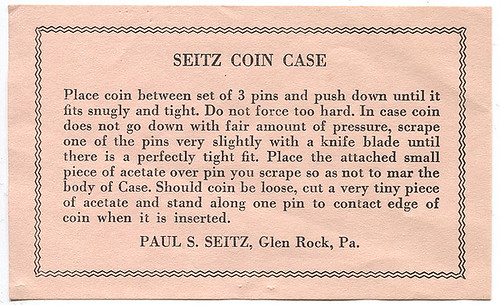
Push till the coin fits snugly and tight, but not too hard. Repair of the holder is discussed and encouraged if you happen to push too hard. Use a knife blade for a perfect fit, being careful not to mar the holder. No mention is made of being careful to not damage the coins, however. I guess with proof and mint state Indian cents fairly worthless in the early 20th century this was not a concern.
Further use of a knife is suggested on one pin only or the coins would be to loose and you would need an entirely new holder. Hey, this is pretty much a holder ahead of its time; only recently have todays grading services gone to edge view holders. Speaking of it is now time to get out the screwdriver and write 'em up for submission to, well you know the rest……….
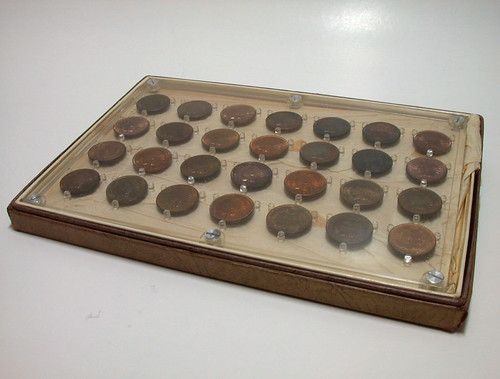
WHITMAN FOLDER PRINTING PLATES
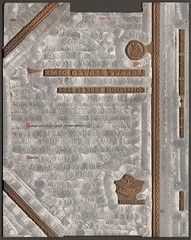 I'm attaching images of two printing plates that were made for Whitman blue folders in the mid-1960s. I acquired these from different sources. The Seated Liberty Dime plate was purchased last week on eBay for a very modest price. The Seated Half Dollar folder cost me a lot more, as I traded a pristine North Carolina colonial note for it about 12-15 years ago. The owner wouldn't sell the plate for cash, but he asked what I had to trade that was of historic interest.
I'm attaching images of two printing plates that were made for Whitman blue folders in the mid-1960s. I acquired these from different sources. The Seated Liberty Dime plate was purchased last week on eBay for a very modest price. The Seated Half Dollar folder cost me a lot more, as I traded a pristine North Carolina colonial note for it about 12-15 years ago. The owner wouldn't sell the plate for cash, but he asked what I had to trade that was of historic interest.
The story behind these plates is that they were intended for use with Whitman's Sixth Edition of folders printed during 1965-67 (these "editions" are defined by my own cataloging and were not so-called by Whitman). The Sixth Edition is identifiable by the eagle logo which appears at lower left on the cover of each folder. Since the coin market was in the dumper at that time, Whitman found that it didn't need to print any more examples of these slow-selling titles. In fact, all Whitman folders for Seated Liberty coins were discontinued at that time, and none are known with the Sixth Edition graphics seen on these plates.
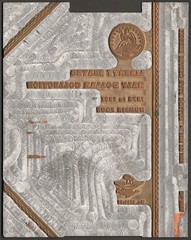 The dealer who traded me the half dollar folder said that he'd received it probably during the late 1970s as a thank-you gift from Whitman that was sent to all of the company's bigger wholesalers of coin products. Printing technology was changing at that time, so they would never be used in any case. How many were sent out and how many of those still exist are unknown but, needless to say, I'm a buyer of all I can get.
The dealer who traded me the half dollar folder said that he'd received it probably during the late 1970s as a thank-you gift from Whitman that was sent to all of the company's bigger wholesalers of coin products. Printing technology was changing at that time, so they would never be used in any case. How many were sent out and how many of those still exist are unknown but, needless to say, I'm a buyer of all I can get.
My plan is to have prints made from these plates and bind or tip them into my projected book on Whitman folders, which I estimate will be Volume Three of my current series on coin albums. Of course, this may be contingent on selling more copies of Volume One, since I'm yet a long way from recovering its cost.
To read the earlier E-Sylum articles, see:
NEW BOOK: COIN COLLECTING ALBUMS, VOLUME ONE
(www.coinbooks.org/esylum_v16n32a02.html)
NEW BOOK: THE NATIONAL COIN ALBUM AND RELATED PRODUCTS
(www.coinbooks.org/esylum_v16n41a04.html)
INTERVIEW: JOHN MERCANTI'S WEDGE-TAILED EAGLE
Here on CoinWeek, Louis Golino reported on the recent release of the Australian Wedge-tailed Eagle high relief one-ounce silver and gold proof coins by the Perth Mint. The bullion coins are being offered for sale in the United States by The New York Mint on their website govmint.com (no affiliation with the U.S. government or the United States Mint), and can also be found through the Perth Mint’s Australian distributors. Ultimately, they’ll be available online at numismatic marketplaces such as eBay or Great Collections. The coins are the first designed by former Chief Engraver John Mercanti since his retirement from the United States Mint in 2010.
Recently, Charles had a quick chat with John Mercanti to ask him a few questions we’d like to share with you on how this project came to be and what the design process was like.
John, how did this program come about?
Well, I met with the Perth Mint’s wholesale manager Neil Vance in Austin, Texas in early 2013 to discuss a possible project. Neil had proposed the idea that I do an eagle design for a bullion coin.
A motif you are well familiar with.
Yeah, I had done and seen a lot of eagles. So, I talked with Neil and the Perth Mint’s Art Director to discuss the specifics of the coin and the technology that their Mint had at their disposal and got to work researching the eagle.
So, I take it the next stop was the Internet
Exactly. I looked through a lot of pictures and saw that the bird has a prominent wedged look when it flies. There were a number of images where its wings were splayed and its plumage was fully articulated and I knew I wanted to do something with that because it would strike up well on a coin.
Did the idea of having the eagle land on a stump come from one of the pictures you found?
Actually, no. But let me back up. Originally, I did two rough drawings. One had an eagle flying in the air with its wings splayed. The second one, the one they picked showed the eagle coming down for a landing.
The first design I did sort of as a back-up. I really wanted to do the design Perth selected.
I saw a few images of the Wedge-tailed Eagle landing, but as an artist you don’t want to copy someone else’s work- you have to make the idea your own. You have to interpret the way the eagle flies and make it interesting. Also, I had never really seen an eagle landing on a coin.
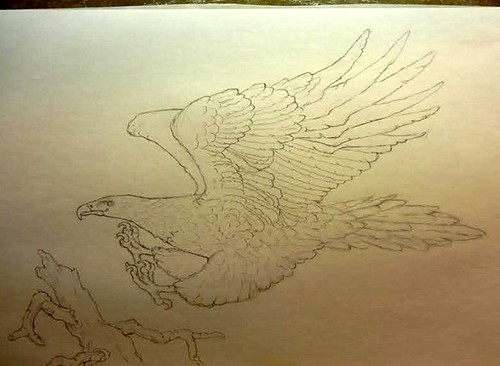
To read the complete article, see: A Quick Chat with John Mercanti on the Wedge-Tailed Eagle Proof Coin (www.coinweek.com/people-in-the-news/quick-chat-john-mercanti-wedge-tailed-eagle-proof-coin/)
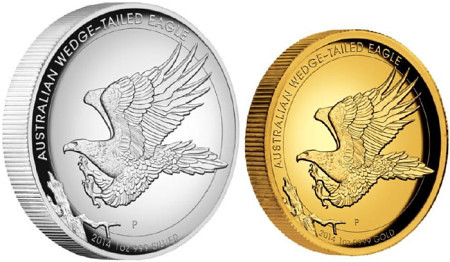
Earlier this month, the Perth Mint released the 2014 Australian Wedge Tailed Eagle High Relief Gold and Silver Proof Coins featuring an exceptional design by former United States Mint Chief Engraver John Mercanti. The coins represented one of the most discussed and well received world releases in years and promptly sold out on the Perth Mint’s website, although US customers were directed to an exclusive regional distributor.
It appears that Mercanti’s design will also be used on as many as three different upcoming coins. Basic details of these upcoming coins can be found in explanatory statements to Determinations that the Perth Mint files to specify the weight, dimensions, and composition of upcoming numismatic coins. In addition to the already released 1 ounce gold proof high relief coin and 1 ounce silver prof high relief coin, the statements provide for the following additional 2014-dated coins:
- 5 ounce .999 Silver Proof High Relief Coin
- 1 ounce .999 Silver Proof Coin
- 1 ounce .999 Silver Bullion Coin
To read the complete article, see: Mercanti’s Australian Wedge Tailed Eagle Design To Appear on More Coins (world.mintnewsblog.com/2014/01/mercantis-australian-wedge-tailed-eagle-design-to-appear-on-more-coins/)
THE BOOK BAZARRE
RANDALL ROSENTHAL'S AMAZING MONEY BOX SCULPTURE
A skill like woodworking takes years and thousands of hours to become more than just a proficient at, but this man invested that time to be a certifiable master. His name is Randall Rosenthal and he has talent that can result in mind-bending illusions. The project in the gallery below all started with three pieces of white pine he glued together. What he turned that block of wood into is so cool.
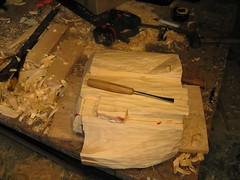

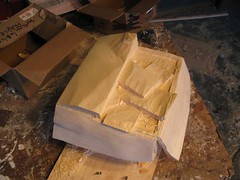
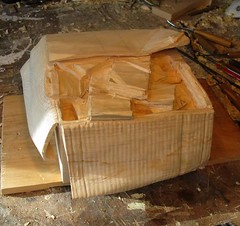
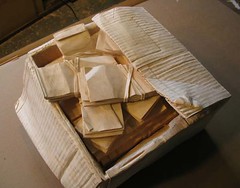
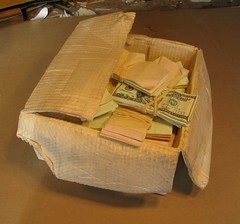
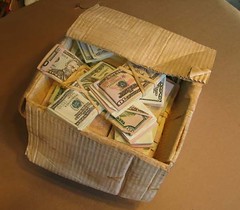
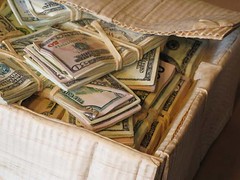
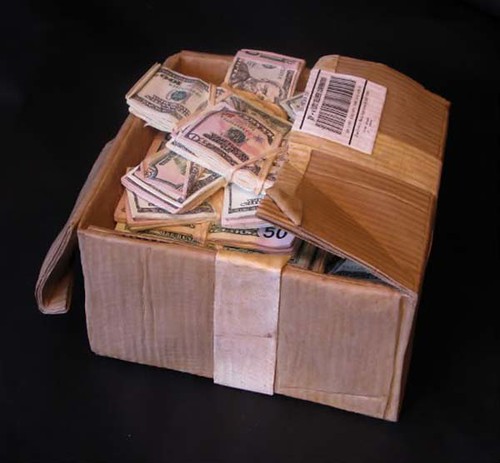
To read the complete article, see: It Looks Like An Awesome Box Of Money. When You Take A Closer Look, It’ll Seriously Blow Your Mind. (www.viralnova.com/box-of-money/)
THE 1960S TAX-RESISTANCE "THOREAU MONEY" NOTES
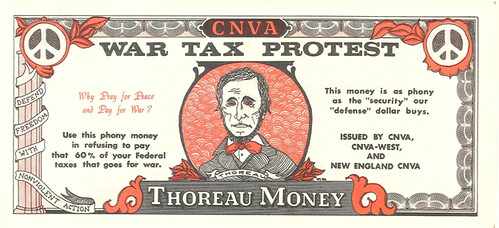
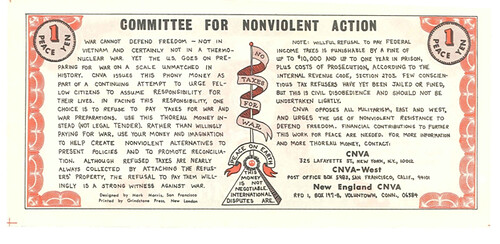
Henry David Thoreau (1817-1862), Transcendentalist author and poet, spent a night in jail in July 1846 for refusing to pay poll taxes because of his opposition to the Mexican-American War and to the practice of slavery.
Given Thoreau’s teachings it was thus appropriate that, more than a century later, the distribution of “Thoreau Money” became a feature of antiwar protests during the 1960s. Produced by the Committee for Non-Violent Action (CNVA) and the War Resisters’ League (WRL), Thoreau Money served as a handbill that explained the theory and practice of war tax resistance.
While Thoreau’s refusal remains perhaps the most well-known American example, war tax resistance dates back before the founding of the American republic. Traditionally undertaken by historical peace churches such as the Quakers, after World War II such tax resistance spread in response to the expansion of a peacetime military establishment and the growth of nuclear arsenals. Groups like the WRL (founded 1923) and the Peacemakers (1948) gave organized expression to pacifism from a secular perspective, including stratagems for avoiding the taxes that paid for war.
As America’s involvement in Vietnam deepened, tax resistance became more organized. A national 10% charge on telephone bills, passed in 1966 to help fund the Vietnam conflict, became a frequent target of war tax resisters, as was the federal income tax itself, to which was added a 10% surcharge in 1968. Tax resisters were counseled to withhold small amounts of federal tax, so as to force the IRS to spend disproportionate amounts in enforcement and collection.
Another common tactic of tax resisters was the declaration of multiple fictitious dependents on their W-4s to reduce their tax bills. In one extreme case, a Quaker couple in North Carolina, Lyle and Sue Snider, claimed 3 billion dependents—about the population of the world at the time! Other protesters went so far as to minimize their incomes through voluntary poverty so as to deprive the government of income.
Two versions of the “War Tax Protest” Thoreau Money exist, both denominated as “1 Peace Yen”. The first, earlier version, was issued by the CNVA, CNVA-West, and the New England CNVA, and features a crude frontal portrait of Thoreau, with red overtones in the scrollwork. Probably derived from the 1856 daguerreotype by Henry David Maxham, it is an unflattering depiction (as Nathaniel Hawthorne once described Thoreau, "he is ugly as sin, long-nosed, queer-mouthed”).
The second, later version uses a facsimile of Samuel Worcester Rouse’s kinder, 1854 crayon portrait of Thoreau as beardless, younger man. Jointly issued by the CNVA and the WRL, this second note features blue overtones in the scrollwork, and dates from after the 1968 merger of the two organizations. Both notes were designed by Mark Morris, an artist associated with CNVA-West, and printed at Grindstone Press in New London, CT. Grindstone Press produced a variety of anti-war ephemera, ranging from handbills and pamphlets to posters, such as Morris’ “Hang up on War” print promoting the CNVA’s campaign against the 10% telephone tax.
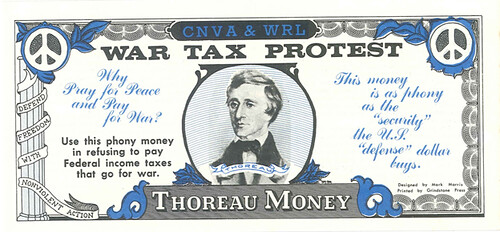
Loren adds:
I had bought a pair of the notes on a whim from Bolerium Books in San Francisco, which specializes in left-wing and other radical literature. I looked into their origins, and the story of "Thoreau Money" just fell into place.
For more information on the Society of Paper Money Collectors, see: www.spmc.org
"NON-COLLECTIBLE" CIVIL WAR TOKEN DESIGNATION SOUGHT
As Civil War token collectors we have been frustrated by not being able to complete many series because one or more of the pieces are not available to collectors. The large cent collectors faced this same problem and they have solved it by designating extremely rare pieces as non-collectable. Collectors can then complete the collectable pieces and call the set complete without having all the pieces.
Heritage is currently selling the fabulous Adam Mervis Large Cent collection. It is advertised as a complete collectable set plus 35 of the 53 NC (non-collectable) varieties. If this set were Civil War Tokens it would be advertised as only missing 18 pieces from being complete. Why not have the glass half full instead of half empty?
The excellent Civil War Tokens book by Q. David Bowers which was released in August 2013 is almost sold out and heading to a second printing indicating the increase in popularity of Civil War tokens. Following the lead of the large cent collectors would make it easier for collectors to have a complete collectable set and then try to get as many NC (non-collectable) pieces as possible.
We would suggest the NC pieces be determined by the experts in the field and be limited to actual designs and ignore metal varieties because most collectors do not collect by metal variety. This same system could also be applied to patriotic Civil War tokens. Since we only have a small collection of patriotic CWTs, another expert can take the lead on them.
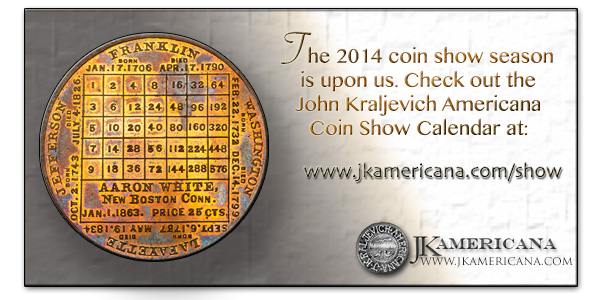
BANK OF ENGLAND SETS DEADLINE FOR OLD £50 BANKNOTES
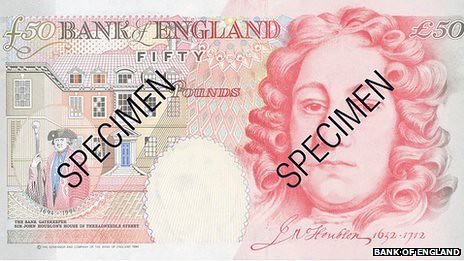
Shoppers with an old-style £50 note featuring the image of Sir John Houblon need to spend it or deposit it by the end of April.
The banknote is being withdrawn from circulation by the Bank of England. The notes can be used until the end of 30 April.
Retailers and some banks can refuse to accept the note after that date.
Sir John was the Bank's first governor. His image was replaced on the new note with Matthew Boulton and James Watt.
The pair feature on the new note partly because they were instrumental in manufacturing coins that were difficult to counterfeit. The note went into circulation in November 2011.
Anyone who has an old £50 note - which was first issued in April 1994 - can exchange it at any bank, or spend it, by the end of April. Any institution can refuse it after that.
However, Barclays, NatWest, RBS, Ulster Bank and the Post Office have all agreed to exchange Houblon £50 notes, up to the value of £200, until 30 October.
Any old notes that no longer have legal tender status can be exchanged at the Bank of England itself at any time.
To read the complete article, see: Deadline set to swap old £50 banknote (www.bbc.co.uk/news/business-25758063)
MUTILATED US NOTES RAISE MONEY LAUNDERING SUSPICIONS
 US federal agents who seized more than 4 million dollars in US banknotes shipped from a famous money exchange house in Buenos Aires, Alfredo Piano, uncovered what they claimed was a cache of dirty money. Piano, 82, said many of the 100 dollar-bills were filthy and others had been ravaged by fire, water and even dogs.
US federal agents who seized more than 4 million dollars in US banknotes shipped from a famous money exchange house in Buenos Aires, Alfredo Piano, uncovered what they claimed was a cache of dirty money. Piano, 82, said many of the 100 dollar-bills were filthy and others had been ravaged by fire, water and even dogs.
Piano’s banknotes became the subject of recent scrutiny in federal court in Washington, where the bills were named defendants in a lawsuit called US v. 4,245,800 in Mutilated United States Currency. In it, the US alleged that the tattered cash that Piano’s Banco had tried to exchange at face value was likely the proceeds of criminal activity.
Piano argued that his bank’s role is to help Argentines get new greenbacks when their old ones get burned, ripped or, in some cases, sent through the washing machine. Hashing out whether the bills fell under the government’s figurative, criminal definitions of dirty and laundered, or merely Piano’s literal ones, took an 18-month legal proceeding and insights from Argentine money-hoarders, the Secret Service and an arm of the US government called the Mutilated Currency Division.
Mounting the defense of his clients’ money, Piano argued that Argentines are world-class stashers of cash dollars, and that misfortune will naturally befall some of the paper money that people hoard in mattresses, walls and holes in the ground.
The US government retires more than four billion notes each year, the Fed says. The cash often comes in from abroad, where half to two-thirds of US currency circulates, most of it in US$100 bills, it says. In October, the US introduced a new US$100 bill with additional security features.
Argentina, which the CIA says is the world’s 33rd-most populous nation, had at least 50bn in cash — about one of every nine dollars then circulating abroad, the US Federal Reserve estimated in a 2006 report.
“There’s nowhere to save dollars, so people bury them in the ground in a box, or put them in the attic,” Piano said. “I have a client who has a normal looking living room, but inside the bricks there are bills — he must have US$1 million or US$1.5 million stacked in there.”
Piano said “a huge amount of wet bills” came in after floods in La Plata earlier this year. He produced a sheet of paper showing handwritten columns listing dozens of customers and the amount each sought to exchange.
To read the complete article, see: Argentine case of possible money laundering with mutilated US dollar bills (en.mercopress.com/2014/01/15/argentine-case-of-possible-money-laundering-with-mutilated-us-dollar-bills)
YOUSUF KARSH AND THE "DEVIL'S HEAD" PHOTO OF ELIZABETH II
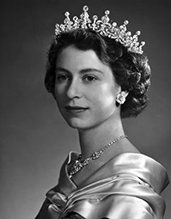 Uys was never the photographer involved. The photo used is one take by Canadian Yousuf Karsh … who was a more respectable and far less notorious shutter bug. The pic was one of many he took at a sitting of The Princess Elizabeth in 1951. All had her wearing a tiara. That was removed from Karsh’s photo in pre-Photoshop days by some cunning folk in darkest Canada. The NEVER retouched the hair not covered by the tiara of the original.
Uys was never the photographer involved. The photo used is one take by Canadian Yousuf Karsh … who was a more respectable and far less notorious shutter bug. The pic was one of many he took at a sitting of The Princess Elizabeth in 1951. All had her wearing a tiara. That was removed from Karsh’s photo in pre-Photoshop days by some cunning folk in darkest Canada. The NEVER retouched the hair not covered by the tiara of the original.
A detailed factual account is available on the Canadian Coin & Currency web site. It contains a pic of the photo used on the banknote. The story proves far more mundane but I do like the two years gap before anyone noticed Old Nick in HM’s tresses and complained. That dates the Devil’s Head as 1956.
There is one error. Coin & Currency state that Karsh’s pics were those of the Queen. Trouble is her dad was still alive. She was still the heir-apparent and a princess at the time of her sitting.
So the Uys and Crowley connection is another numismatic myth that needs burying deeply altho’ my experience tells me it will never go away.
PS I have not been able to confirm that Uys took any photos of Her Majesty at any time. Given that he was an openly homosexual and that was still a significant crime in Old Blighty in the 50s, I doubt if the royal retainers at the time would have allowed him within a stone’s throw of HM. It is likely that her hubby may well have been rather outspoken on the subject.

To read the complete article, see: The Devil's In the Details: The Story of the Devil's Face (www.cdncoin.com/kb_results.asp?ID=14)
To read the earlier E-Sylum articles, see:
THE 1954 “DEVIL’S FACE” CANADIAN BANKNOTES
(www.coinbooks.org/esylum_v17n01a23.html)
YVES BARIL AND THE "DEVIL'S HEAD" PORTRAIT
(www.coinbooks.org/esylum_v17n02a10.html)
THE BOOK BAZARRE
SELECTIONS FROM THE STACKS BOWERS 2014 AMERICANA SALE
Lot 133: 1866 Springfield Antiquarians Card

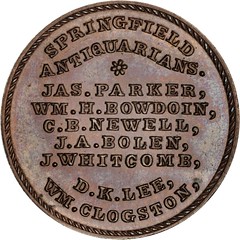
1866 Springfield Antiquarians Card. Copper. 28 mm. 10.5 grams. Musante JAB-23. Mint State.
One of just 14 reported struck in copper, with just one or two believed struck in each of several other metals. A very rare issue. Interestingly, Bolen first signed this obverse die just below the shield and to the right, and traces of the LEN are still clearly visible. The final position is boldly at the base of the central motif, just above the date.
Pedigree: From the Neil Musante Collection. Paper envelope with attribution notation included.
To read the complete lot description, see:
2014-Americana Lot #133
1866 Springfield Antiquarians Card. Copper
(www.stacksbowers.com/BrowseAuctions/LotDetail/
tabid/227/AuctionID/5001/Lot/133/Default.aspx)
Lot 245: Silver Urn. Ephraim Brasher
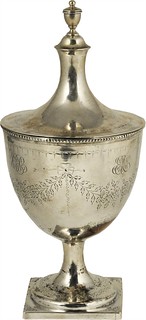 Silver Urn. Ephraim Brasher (1744-1810). Active ca. 1786-1807. New York, New York.
Silver Urn. Ephraim Brasher (1744-1810). Active ca. 1786-1807. New York, New York.
Silversmith Mark: EB in incuse rectangular punch, stamped four times beneath base. Urn: 14.2 inches topped with approximately 10 inch removable lid. Total weight 283.5 grams. Urn-shaped body on short foot set on square base. Applied band of beading across rim of urn with ornate initials and floral pattern on body and foot. More reserved design work is also present along the base of the lid, and there are leaf patterns impressed into all four corners of the square base.
To read the complete lot description, see:
Lot 245: Silver Urn. Ephraim Brasher
(www.stacksbowers.com/BrowseAuctions/LotDetail/
tabid/227/AuctionID/5001/Lot/245/Default.aspx)
Lot 1792 Roman Head Cent
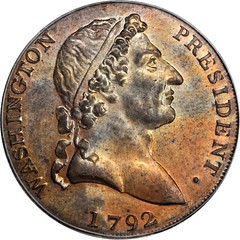
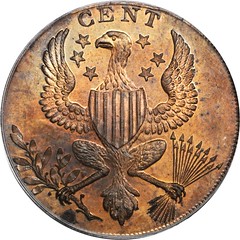
1792 Roman Head Cent. Baker-19, W-10840. Rarity-6.
This famous issue features a bust of Washington to right with Roman-style hair in ribbon and WASHINGTON PRESIDENT around, date below, reverse with CENT above a stylized heraldic American eagle. Readily among the most important and elusive of all Washington-related types, with perhaps just 15 or so pieces known in all grades, including one example called Proof-08. Made in England during the height of the Conder token craze, the die work is by then 17-year old John Gregory Hancock, a child prodigy who first gained recognition during the Conder token era, 1788-1800 or so.
Something on the order of only two or three dozen examples of this rarity are thought to have been made, no doubt on special order for the well-heeled collectors of the era who demanded more and different tokens at every turn. The majority of the pieces known today are of relatively high quality, a sign they were kept and cherished by the original recipients and so on down the line to today's collecting community.
To read the complete lot description, see:
Lot 379: 1792 Roman Head Cent.
(www.stacksbowers.com/BrowseAuctions/LotDetail/
tabid/227/AuctionID/5001/Lot/379/Default.aspx)
Lot 2045: 1802 Half Dime
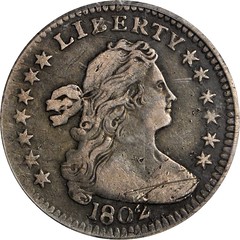
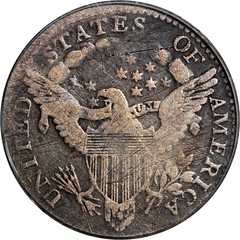
1802 Draped Bust Half Dime. LM-1, the only known dies.
The first 1802 half dime to sell at public auction is believed to be the William A. Lilliendahl Collection specimen in December 1863. This piece was then described as the finest of the three known specimens, although Harold P. Newlin noted the coin was in only "Very Good condition." That coin sold for $340, a record price that stood for a generation until Newlin's own finer specimen of this rarity was sold at auction. Furthermore, one of the finest known 1794 silver dollars brought a comparable $285 in another auction in 1863 confirming that American numismatists at the time had a firm grasp on the rarity of the 1802 half dime.
The original mintage is believed to be a mere 3,060 pieces, and these suffered great circulation challenges; these small silver coins simply did not survive intact. Researcher David J. Davis studied this issue extensively and with the help of numismatic organizations and other well known numismatists concluded that no more than 35 distinct examples exist (published in his extensive listing of all known auction appearances in the reference Federal Half Dimes 1792 - 1837 by Russell J. Logan and John W. McCloskey in 1999).
Since that time David Davis has passed away, but shortly before his death we discussed the issue and he believed that perhaps as few as 25 distinct examples exist, as a few of those previous auction offerings were found to be counterfeits -- or repaired and straightened coins previously listed as bent or damaged.
Remarkably the 1802 half dimes in both the Smithsonian's National Numismatic Collection and the American Numismatic Association Museum are altered dates and thus not included in the census.
Much has been written about this particular issue. The first such research was conducted by leading numismatist of his era Harold P. Newlin, in 1883, when he published his work titled A Classification of the Early Half-Dimes of the United States soon after he sold his collection of half dimes through J.W. Haseltine on April 10, 1883.
In that publication Newlin enumerated most of the known auction appearances, and deemed it a "most exalted" rarity. At that early time, Newlin was able to list 16 appearances and gave a thorough presentation as to why he was of the opinion that the 1802 half dime was "the most desirable [rarity] of the silver series," eclipsing other pieces famous at that time including the 1804 dollar, and quarters of 1823 and 1827.
To read the complete lot description, see:
Lot 2045: 1802 Half Dime
(www.stacksbowers.com/BrowseAuctions/LotDetail/
tabid/227/AuctionID/5001/Lot/2045/Default.aspx)
To browse the complete sale, see:
www.stacksbowers.com/BrowseAuctions/LotListing/
tabid/225/AuctionID/5001/Default.aspx
SERVICE AGENT CHARGED WITH PASSING COUNTERFEITS
The former Secret Service agent charged with stealing and using confiscated counterfeit money got into a back-and-forth exchange with a judge about whether he should be required to turn over his guns Thursday afternoon at a bail hearing. Anthony Eugene Preissig of Saint Johns also took offense when the prosecutor spoke of his family in open court. Vincent Citro, lead prosecutor in the case, said Preissig was arrested Thursday morning at his home on Worthington Parkway. The 47-year-old Preissig, who has since retired from the Secret Service, told the judge he doesn’t present a danger to anyone.
According to the charging document filed in federal court, Preissig investigated instances of counterfeit money at the Jacksonville Secret Service office before he left the office.
He is accused of stealing the fake notes sometime after Oct. 17, 2011. The amount exceeded $1,000. On Halloween in 2011, Preissig used a fake $100 bill at a gas station in St. Johns County, the charging document said.
Preissig denied stealing counterfeit notes and said he did not know the $100 bill he used on Halloween was fake or know where he got it, according to court records.
The U.S. Attorney’s Office maintains Preissig lied to a special agent of the Department of Homeland Security and to a Secret Service inspector when he told them those statements in November 2011.
During court proceedings, Preissig told the judge he is undergoing psyco-dynamic therapy for bipolar disorder, manic depression and obsessive-compulsive disorder in response to a question about medications he currently takes.
Toomey called Preissig’s decision to represent himself unusual and scheduled a hearing on the matter to make sure he understood the implications.
To read the complete article, see: Former Secret Service agent from St. Johns charged with stealing fake money (members.jacksonville.com/news/crime/2014-01-16/story/former-secret-service-agent-st-johns-charged-stealing-fake-money)
BASIC INTERGLUTEAL NUMISMATICS
David Klinger writes:
Have you ever heard of Basic Intergluteal Numismatics? It is the title the third TV episode of the fifth season of Community, which originally aired on January 9, 2014 on NBC. The plot involves the Ass Crack Bandit, whose MO is to drop a coin (25c) down the back of someone's pants when they lean over. I'm not making this up!
To read the Wikipedia article, see: Basic Intergluteal Numismatics (en.wikipedia.org/wiki/Basic_Intergluteal_Numismatics)
To read a review of the episode, see: TV review: 'Community' Season 5 Episode 3, 'Basic Intergluteal Numismatics' (boingboing.net/2014/01/10/tv-review-community-seaso.html)
FEATURED WEB SITE: WORLD OF COINS
This week's Featured Web Site is suggested by Yosef Sa'ar, who writes:E-Sylum readers may find it valuable to read and/or join the World of Coins internet forum. They have an wonderful section for numismatic books, especially non-North American.
www.worldofcoins.eu
